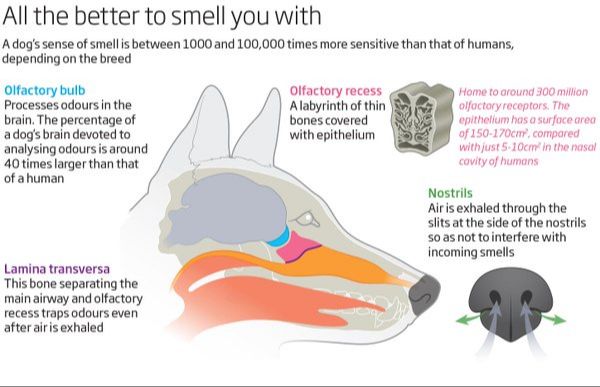Introduction
A dog’s sense of smell is their superpower. With over 300 million scent receptors in their noses, dogs can detect odors at concentrations of 1-2 parts per trillion. That allows them to pick up even the faintest of scents from incredible distances. Compare that to humans, who have only 5 million scent receptors. When it comes to our noses, dogs have the clear advantage.
This article explores the anatomical differences that give dogs such an astounding sense of smell compared to humans. We’ll look at their impressive scent detection abilities, like tracking and health detection, and how their evolutionary history shaped this ability. After learning about the canine nose, you’ll gain a true appreciation for why dogs are often called “man’s best friend.”
While humans rely heavily on sight, dogs experience the world primarily through their noses. This gives them scent superpowers far beyond what we can imagine. When it comes to sniffing out odors, there’s no contest – dogs win paws down.
Anatomy
A dog’s nose contains many more scent receptors than a human’s does. The structure of a dog’s nose is also specialized to pick up smells much more efficiently.

A dog has around 300 million olfactory receptors in their nose, compared to only around 6 million in humans. Their nostrils have folds creating a large surface area, and the part of their brain devoted to analyzing smells is around 40 times larger than in humans.
Dogs also have something called the Jacobson’s organ in the roof of their mouth. This organ picks up pheromones and flavors when dogs lick or sniff objects. All these anatomical differences make dogs’ sense of smell around 10,000 to 100,000 times more sensitive than humans.
Scent Detection Abilities
Dogs have an incredible sense of smell that far surpasses humans’ limited abilities. Their powerful noses allow them to detect scents that we cannot.
For example, dogs can smell chemical changes in the human body that may indicate illness, such as cancer or diabetes. Their olfactory abilities enable them to detect extremely diluted odors, with some studies showing dogs can pick up a scent diluted to 1 or 2 parts per trillion. This allows them to sniff out drugs, explosives, and contraband that a human would never notice.
Dogs also use their sense of smell for tracking. They can follow a person’s trail for miles by detecting skin rafts containing that individual’s distinct scent. Their ability to discriminate between different people’s scents allows dogs to identify and track specific individuals.
Overall, dogs can smell subtleties in odors that humans miss entirely. Their superior olfactory capabilities allow them to gather information about the world around them using their noses alone.
Tracking
Dogs have been used for tracking people and objects for centuries. Their incredible sense of smell makes them ideal for search and rescue operations. Dogs can pick up the faintest scent and follow it for miles, even days after the person or object passed by. Bloodhounds are one of the breeds most associated with tracking, with their long drooping ears helping to waft scents towards their nose. But many breeds have been used for tracking including German Shepherds, Labrador Retrievers and Beagles.

Some of the most dramatic examples of dogs’ tracking abilities come from search and rescue situations. Dogs have located people buried under avalanches and rubble, led rescuers to lost children in the wilderness, and tracked down criminals on the run. Their tracking skills combined with their agility and loyalty make dogs an invaluable partner for search and rescue teams. Studies have shown dogs can identify individual scents even among a crowd of people, picking out the unique chemical signature of a missing person. With proper training, dogs can follow trails over all kinds of terrain, through water, and even days or weeks after the person initially passed by.
Health Detection
A dog’s incredible sense of smell allows them to detect various health conditions and diseases in humans. Some of the main health conditions dogs can identify include:
Cancer Detection
Dogs have proven capable of detecting certain cancers such as prostate, breast, colorectal, and melanoma by sniffing biological samples like urine or breath. Cancer cells produce volatile organic compounds that dogs can pick up on even in minute concentrations. Research suggests trained dogs can identify cancer with over 90% accuracy.
Seizure Prediction
Some dogs seem to have an innate ability to predict seizures and can alert people before they happen. Dogs likely pick up on subtle chemical changes that occur right before a seizure. Having a dog that can warn of impending seizures can give people with epilepsy critical time to get to safety.
Other Diseases
Dogs’ highly advanced sense of smell allows them to detect a range of other diseases as well. Dogs can be trained to sniff out low blood sugar in diabetics, alert to drops in blood pressure, and sense when someone with Parkinson’s is about to freeze up. Their early warnings for various conditions can be lifesaving.
Emotions
Not only do dogs have an uncanny ability to detect and distinguish different scents, they can also detect subtle changes in human emotions purely through their sense of smell. Dogs have up to 300 million scent receptors in their noses, allowing them to pick up on incredibly nuanced information from scents and pheromones. This includes being able to smell fear, anxiety, sadness, and even epileptic seizures.
When humans experience emotions, we give off subtle chemical signals that communicate our emotional state. While we may not be consciously aware of these signals, dogs can detect them through their highly attuned sense of smell. The smell of fear and anxiety triggers specific reactions in dogs, causing them to be more alert, cautious, and even protective of their owner. On the other hand, when dogs smell happiness and relaxation from their owners, they tend to also become more calm and at ease.
A dog’s ability to smell emotions allows them to be highly in tune with human emotional states. Dogs can pick up on rising tension, mood changes, and even signaling an impending seizure or diabetic emergency. Researchers believe evolution has shaped dogs’ brain structures to be highly sensitive to processing emotional cues from smells. This allows dogs to form tight social bonds with humans and respond caringly to our emotional needs.
Comparison to Technology
Dog noses are virtually unparalleled when it comes to detecting small concentrations of odor molecules, which has led many researchers to study them in hopes of improving artificial scent detection technology. Dogs can detect some smells at concentrations of just a few parts per trillion. Their noses contain over 300 million olfactory receptors, compared to only 6 million in humans. This allows them to detect a wider range of scents and tease apart the components of complex odors.
Current artificial scent detection technology, such as gas detectors and electronic noses, are not as sensitive or discerning as a dog’s nose. Gas detectors rely on sensors calibrated to pick up specific compounds, so they cannot detect new scents they have not been programmed for. Electronic noses try to mimic dogs by incorporating arrays of different sensors, but they lack the processing power of a dog’s olfactory cortex to make sense of complex scents. Engineers have attempted to replicate the structure of a dog’s nose, but the capabilities do not come close yet.

While instruments like gas chromatographs and mass spectrometers can detect very low concentrations of compounds, they are expensive, non-portable, and require dedicated operators. Dogs provide a sophisticated mobile scent detection system, trained to pick out target odors and alert their handlers through barks or sitting. Their keen noses also bypass the limitations of machines that can only “smell” what they are designed for, allowing dogs to pick up on unusual scents that might indicate a problem.
Evolutionary Explanations
A dog’s incredible sense of smell can be explained by evolution. As predators that hunt by scent, dogs’ ancestors relied on their powerful noses to find food and survive. The ability to detect prey or potential threats from great distances provided a significant evolutionary advantage.
Over many generations, natural selection favored dogs with more acute scenting abilities. Their nasal anatomy evolved to maximize olfactory receptors and airflow. Genetic variations that improved scenting skills became dominant. This accounts for why all dogs have such sensitive noses compared to humans.
However, evolutionary pressures weren’t identical for all canine breeds. For example, scent hounds were selectively bred to follow scent trails during hunting. As a result, they developed millions more olfactory receptors than sight hounds that hunt by vision. The powerful nose of bloodhounds emerged from specialized breeding to track humans over long distances. Differences across breeds demonstrate how evolution tailored dogs’ senses of smell to fit their function and environment.
Impact on Dogs
A dog’s incredible sense of smell can be both a gift and a challenge in modern life. With so many artificial scents in today’s world, the sheer intensity of smells can easily overwhelm dogs.

Dogs experience smells much more vividly than we do. Walking down a busy city street, they encounter an onslaught of odors we can’t even detect. Strong perfumes and air fresheners, vehicle fumes, and synthetic materials can cause sensory overload.
As dog owners and companions, we need to be mindful of our pet’s super-sniffer. Look out for signs of stress or anxiety triggered by intense scents. Avoid using heavily scented products around dogs. Provide secure spaces they can retreat to for “olfaction breaks.” Work at positive desensitization to help tune out overwhelming odors.
Understanding a dog’s exquisite sense of smell allows us to make their world more comfortable. Simple changes to reduce scent stimuli can make a big difference for our canine friends.
Conclusion
In summary, dogs have an extremely acute sense of smell that far surpasses that of humans. A dog’s nose has up to 300 million scent receptors compared to only 6 million in humans. This allows dogs to detect odors at concentrations of 1 part per trillion, the equivalent of finding one drop of a substance in 20 Olympic sized swimming pools.
Dogs rely on their powerful noses to track people, animals, and objects, detect dangerous substances and explosives, find disaster victims, identify health conditions, and understand human emotional states. Their sense of smell has evolved to play an integral role in their lives and interactions with people.
While technologically advanced devices are being developed to mimic canine scent detection abilities, dogs still reign supreme. Their olfactory prowess allows them to accomplish remarkable feats daily, cementing dogs as man’s best friend and heroic companions.
The key takeaway is that a dog’s sense of smell is far more powerful and complex than that of humans. Their incredible odor detection capabilities are unmatched and allow dogs to perceive the world through scent in ways we can barely imagine. Understanding the science behind their supernatural sniffers allows us to further appreciate dogs and their special abilities.